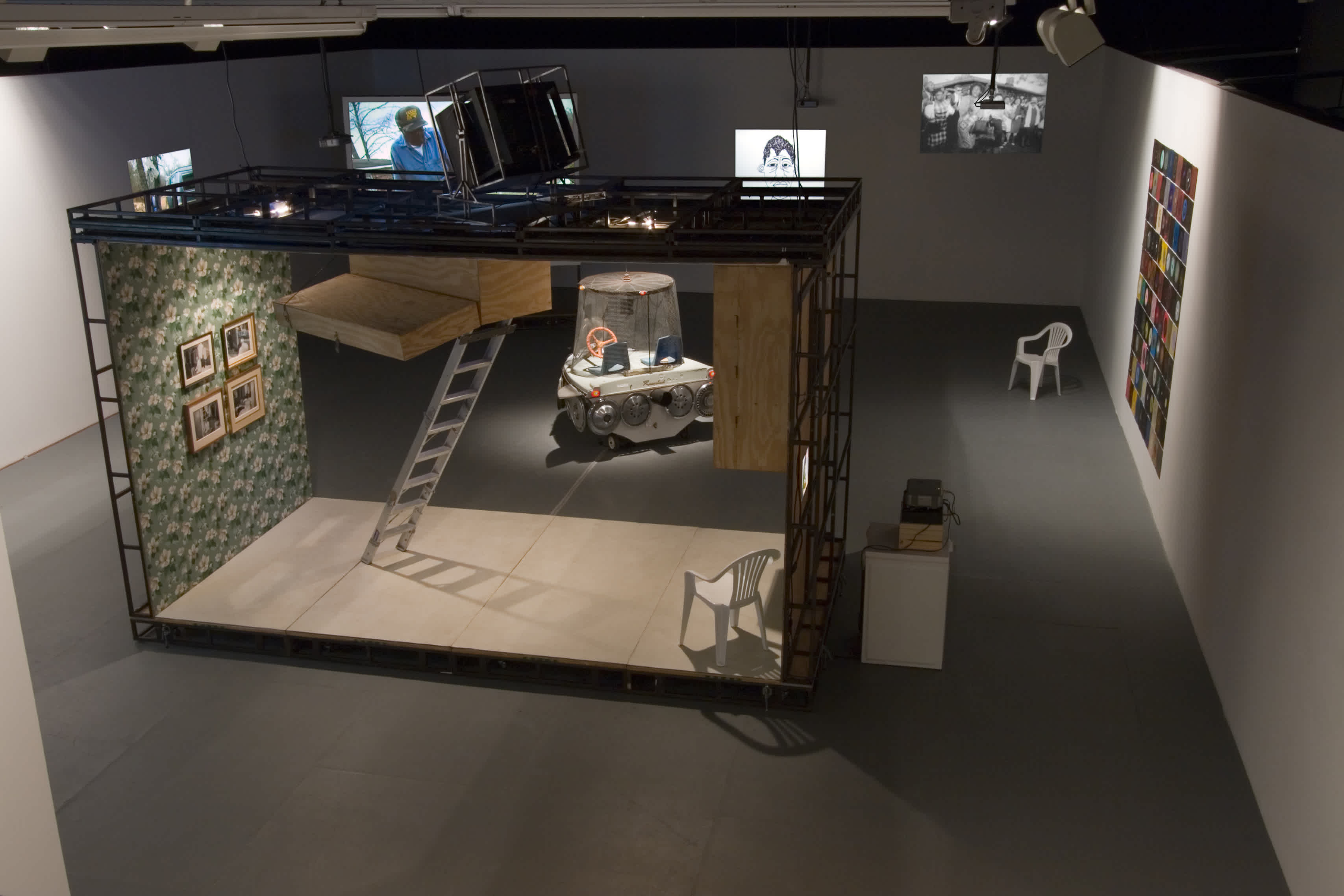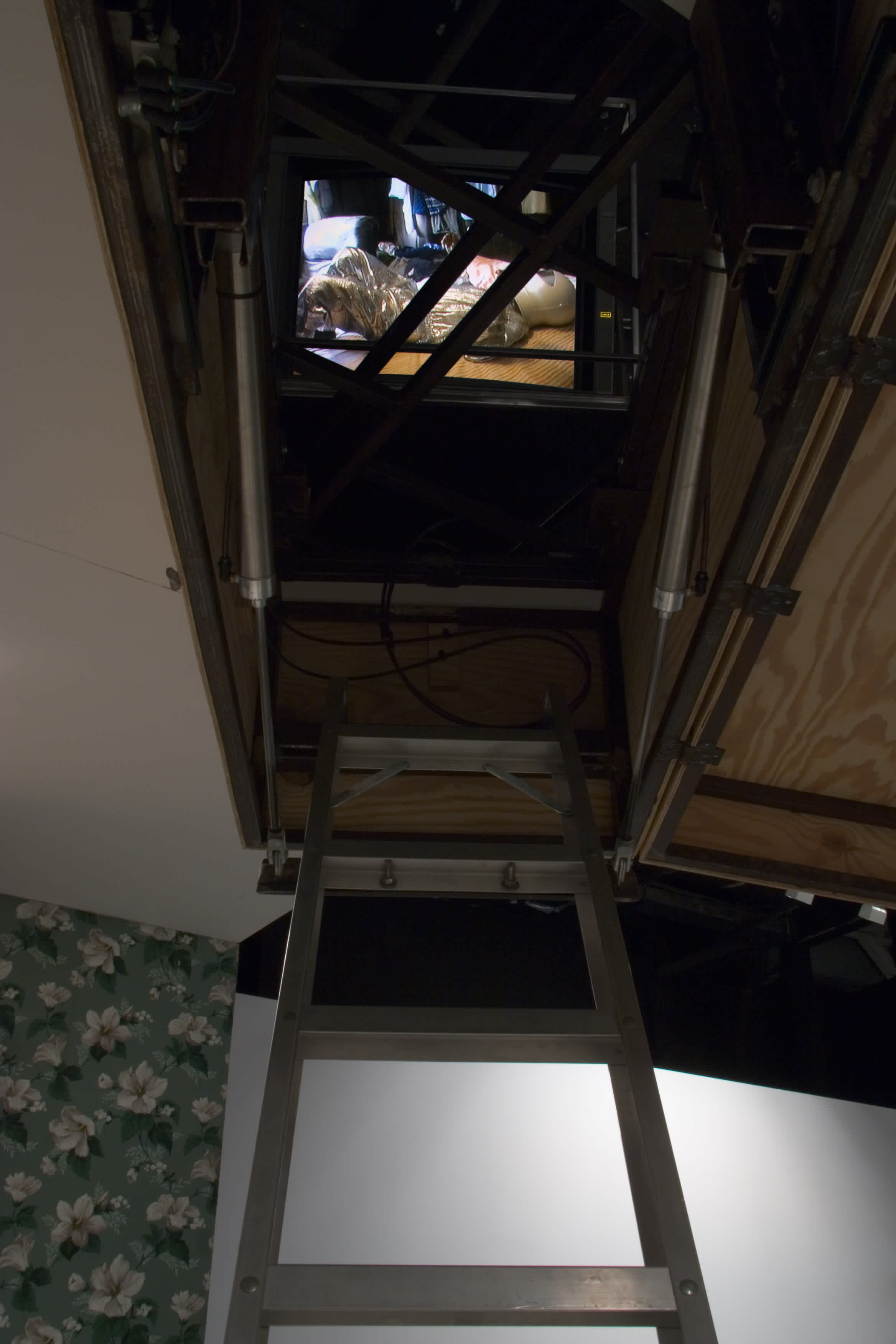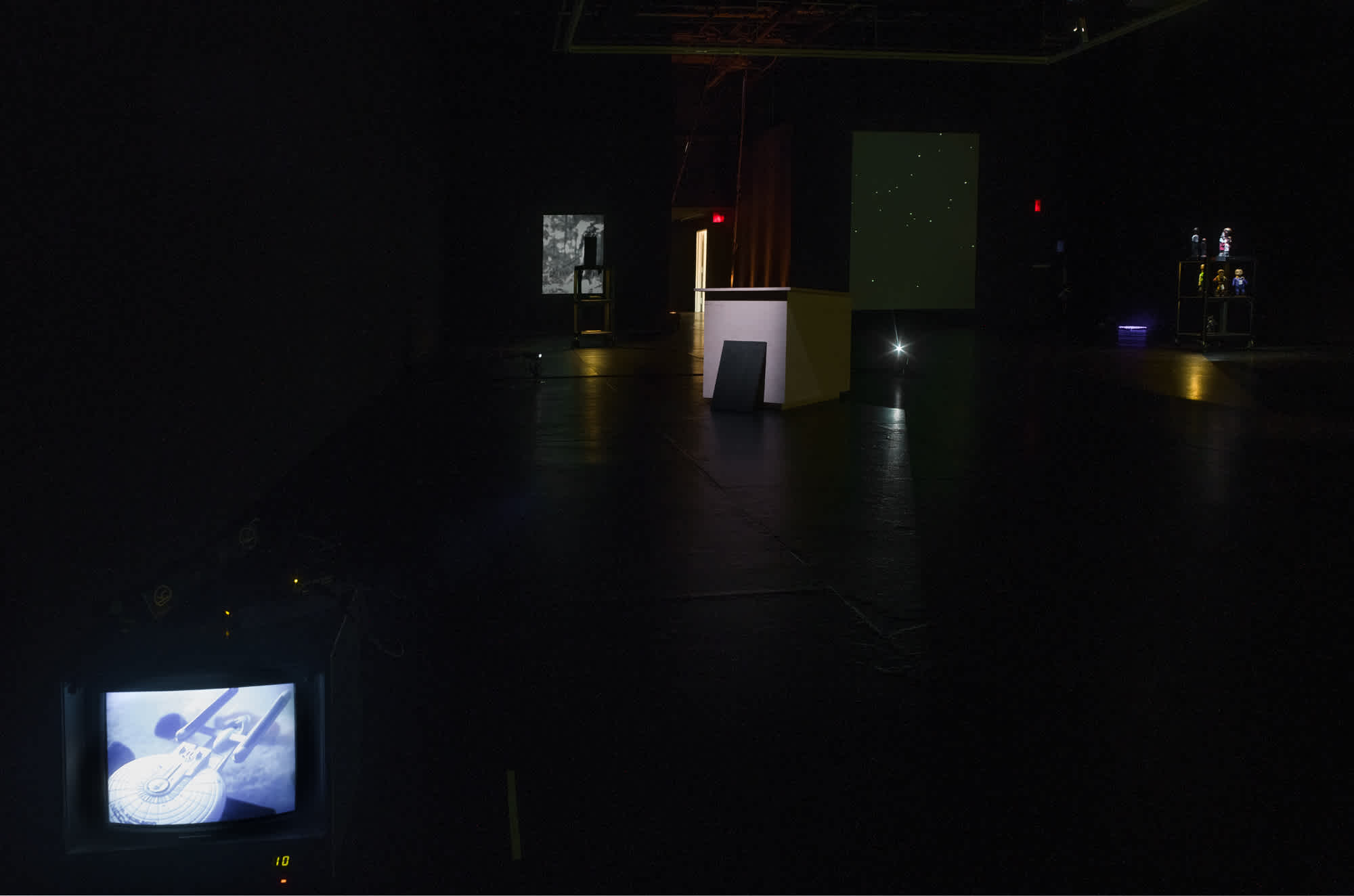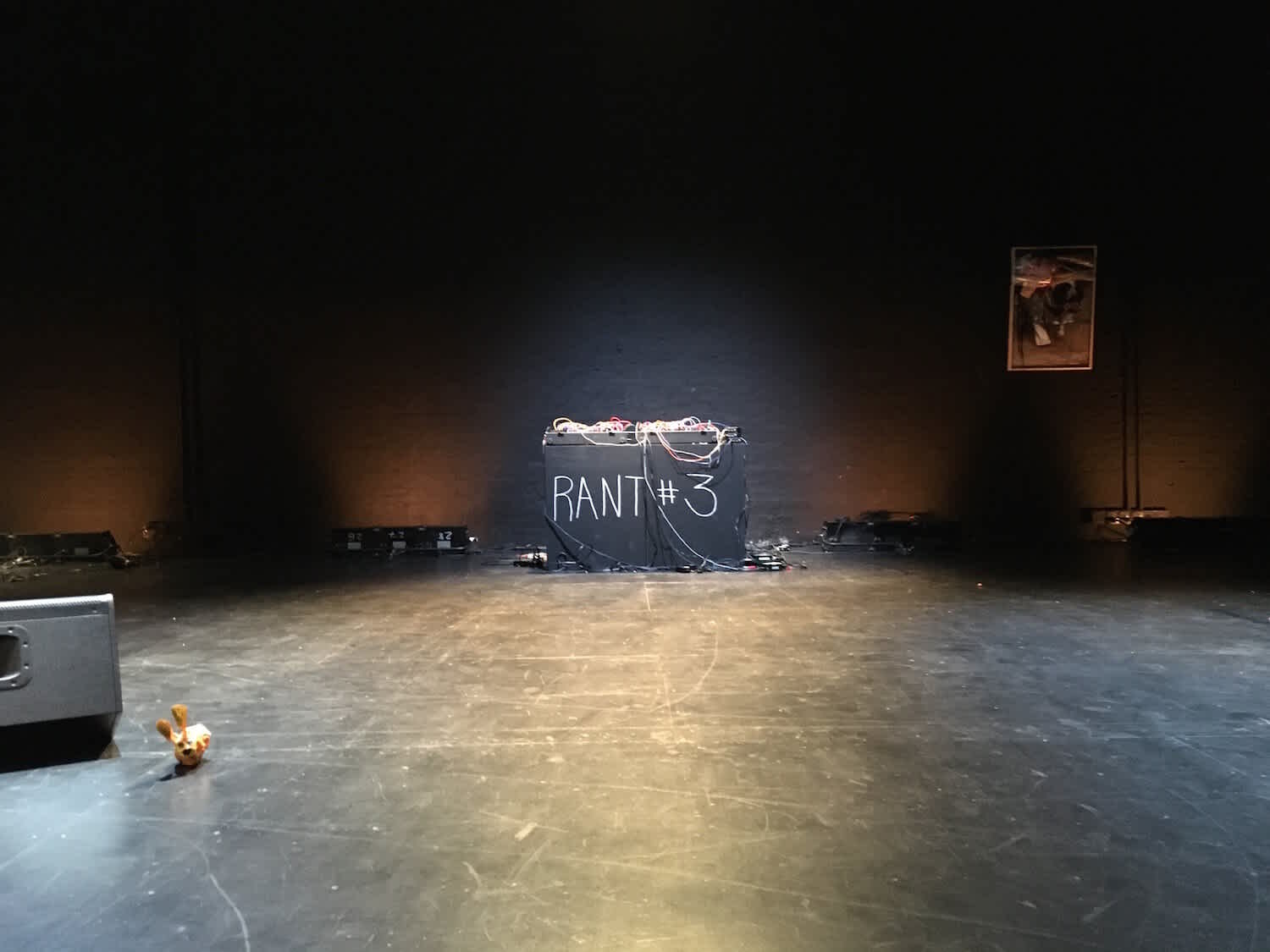
Credits:
Annabel Paran, Fall 2020–Winter 2021 Curatorial Intern
February 2, 2021
As early as the 1980s, Ralph Lemon has presented work at The Kitchen, which has proven a setting uniquely suited for his interdisciplinary practice merging mediums such as dance, visual art, performance, and writing. Last year, Lemon was awarded the 2020 MacArthur Fellowship in recognition of his capacity to interweave stories, identities, feelings, and memories to transcend conventional categories of knowledge and representation.
Against this backdrop, and in recognition of his participation in The Kitchen’s current benefit exhibition Ice and Fire, I found myself wishing to revisit Lemon’s practice and the paths the artist has taken at The Kitchen over the years. In this article I will explore three of Lemon’s shows across his time at The Kitchen— (The efflorescence of) Walter (2007), Scaffold Room (2015), and Rant #3 (2020)—basing my accounts on archival materials including video recordings, documentary footage, press releases, and interviews.
Lemon’s relationship with institutional discourse can be considered a defining element of his poetics. Throughout my analysis of his shows at The Kitchen, I suggest that Lemon’s artwork deliberately refuses conventional and institutionalized classifications as a form of resistance, resulting in a subversive aesthetic of uncertainty. Within educational institutions, the art market, and the culture industry at large, legibility is often a symptom of systems of commodification and evaluation. When interacting with these systems, one is often demanded to articulate one's identity through the system’s clear, external, predetermined terms. In turn, such clarity can mark an appropriation of human experience and spirit in order to generate profit and preserve power relations and control. Lemon does not operate fully outside these systems: instead, he employs various devices of fluidity to disrupt normative, institutionalized categories of knowledge and classification. The clarity required for traditional distinctions collapses in the face of his art: Is this documentary or fictional? Is this an object or an event? A dance or a monologue? Taking the system’s building blocks and reconfiguring them to transgress their initial functions, Lemon appears to be dancing with the Institution: institutions of knowledge, institutions of identity, and language itself. Is it possible to draw the outlines of this “dance”?

PERHAPS LEMON’S ABILITY TO WORK SIMULTANEOUSLY from within and alongside institutionalized form has something to do with instability or motion: an intentional blur of traditions of representation as a type of aesthetic ammunition. When Lemon presented (The efflorescence of) Walter at The Kitchen in 2007, he was already a highly acclaimed choreographer, experimenting with conventions of creative form and narrative. Yet, in this instance, he turned to a new medium. The multimedia show included video work, drawing, painting, animation, and sculptural installations. Thematically, it continued Lemon’s past examination of cultural memory in the intersection of race, place, and identity. The exhibition came two years after his completion of The Geography Trilogy (1997–2004), a three-part, interdisciplinary research and performance project that spanned ten years and three continents and involved multiple collaborators. In 2002, while working on the trilogy’s third part, Come Home Charley Patton (2004)—an immersive, embodied exploration of history, memory, and race in the American South—Lemon met Walter Carter, then a 95-year-old Black man who was a lifelong resident of Yazoo City, Mississippi and who was known as the oldest man in that town. In the following years, Carter shared with Lemon his knowledge of the place and its past as they became friends and creative partners, working together until Carter’s passing at 103. Continuously re-emerging in Lemon’s work, Carter and Lemon’s relationship appears first as the heart of (The efflorescence of) Walter.
In this exhibition, both subjects and objects were rendered indeterminate, and therefore became uneasily classifiable for conventional thought. Entering the show, one encountered a piece called Attic Space (2003/2006)–a stage-like, self-contained construction, in which a folding ladder led into a second floor. At the edge of the ladder was a monitor with a video of Carter lying on a bed in a metallic spacesuit. The attic’s exposed structure was free-standing in the center of the room, thus suggesting it was incomplete and transient—a fabrication alluding to a place external to the gallery. Within the structure on a green wallpapered wall were small, framed black and white photographs of Carter in a bedroom, sitting, seen from behind, or lying face down fully clothed. Like strange family photos, the images convey both extreme intimacy and a certain performativity. The central video-installation featured raw, home-movie quality video projections of Carter performing various tasks as Lemon offers commentary off-camera: Carter repairs broken records using tape; Carter shatters a ceramic bunny with a rock in his backyard and then buries it.
Centered around a biographical character but disregarding distinctions between fact and fiction, the exhibition set up an amorphous space of parafiction. Who are Lemon and Carter in the context of this artwork, what roles and stories do they enact? One review of the show described Carter as “an embodied history of southern past.” While he may be that, he is also irreducible to this history—and that might be the point in this show. Placing Carter’s character in the center of the exhibition, Lemon set up the institution to prompt its audiences to expect a certain type of story: a stereotypical story one might expect of Black identities, historically othered when presented in an art space; potentially a tale of either victimhood or survival, featuring an easily fetishized, elder, Southern, Black body. But Lemon then defies this expectation, refusing a coherent translation of historical narrative into a determinate character. Various aesthetic choices throughout the show illuminate Carter as endlessly more than an emblem, including the way the Carter’s actions elude fast or singular interpretation, the implementation of space-travel references, and Lemon’s narration over the footage. Instead, these elements speak to a human experience and a rich relationship in which there is sharing and forgetting, choice and refusal. 99-year-old Carter is a witness to a century of life—Black life in the American South—and Lemon is witnessing him as such. But the witnessing of both does not simply translate into giving account. Rather, there is a remembering and there are actions (be it dancing, breaking, fixing, or gardening)—separate but interconnected, simultaneous but fragmented. There is bodily memory, and the body is alive but also old, and undergoing constant change. Similarly, there is landscape—both mute and telling of the past, “depends on who’s looking,” says Lemon. (1) Here, we are looking at Lemon looking at Carter looking at the landscape; and the landscape itself is also alive and changing. Revealing this elaborate web of sensuous components-in-flux allowed Lemon to present viewers with the rich incoherence that makes up a history.
In tandem with its fracturing of stereotypical depictions of Black identity and narrative, (The efflorescence of) Walter also questioned artworks’ performance as fixed objects in art spaces. The exhibition explored what occurs when a personal relationship and immersive research are rendered presentable and public, objectified in a gallery context. What exists outside the institutional display are personal relationships, bodily research, and ephemeral processes of discovering and making. But often objects in a gallery are rendered “finished,” done and stationary. Here, however, presentability was muddied up with rawness and an ongoing incompleteness rooted in process. Along with the “attic-space,” another central sculptural piece in the show is a spaceship that Lemon built together with Carter and his community, made out of old auto-parts from Carter’s backyard: a community project performing as a fine art object. Several of Lemon’s sketchbooks with little notes and drawings—private objects emblematic of the artist’s process—were out on display. These examples as well as other various elements of this show hinted at a certain friction that occurs in this translation of process to art-object, suggesting the artworks’ performativity as art objects and alluding to a continuum of their existence elsewhere, outside of the gallery space. The “open seams” aesthetic and alluding to a temporality and spatiality that extend beyond the gallery site established a certain fluidity between the live process and the object in this exhibition, destabilizing the presumption that what is presented in the gallery is in fact complete.
I wonder if the “unstable” nature of the space that is The Kitchen factored into Lemon’s freedom to present his research in visual art form for this project. The Kitchen is not only a gallery space: it is also a dance space, a performance and live art space—a space whose organs aren’t of fixed function but are undergoing a constant metamorphosis. It has been, from its very origin, a place of multiplicity and mutation, transforming each time an artist experiments between its walls. Did (The Efflorescence of) Walter absorb the reverberations of moving bodies and music, of possibility and ephemerality that surrounded it as it stood in The Kitchen’s gallery? Within this space, the exhibition destabilized both habitualized ways of perceiving history and identity and the ways one understands artwork to live (or die) within different frames. These are connected because both melt down distinctions audiences use to navigate through the world; both have something to do with our ability to re-imagine relations. Through this exhibition, Lemon put a mirror to the way things are in order to show they don’t have to be so—opening a secret shaft to another, less predictable way of being, agitating what we think of as determinate or separate, plausible, and possible.

LEMON FURTHER EXPANDED THIS MULTIPLICITY in his later work at The Kitchen. In 2015 Lemon presented Scaffold Room, a multimedia exhibition that spread across The Kitchen’s first and second floors, as well as parts of the lobby and staircase. Merging text, music, and visual art installation, Scaffold Room additionally included performances featuring Okwui Okpokwasili and April Matthis, as well as video appearances by Carter’s wife Edna Carter and Edna’s family members. Alongside the performances and installation, the exhibition encompassed two artist talks and several reading events with guest readers, who read from an array of graphic texts grappling with issues of power, sexuality, and identity. Through these many components, the show continued Lemon’s practice of complicating questions about art’s frameworks. Primarily, however, Scaffold Room is a beautiful and devastating kaleidoscopic portrayal of Black female identities in American culture, emerging through a constellation of historical and cultural icons.
Scaffold Room’s live performance begins with an unfathomable weep. On a monitor attached to a stage-like structure in The Kitchen’s first-floor theater, viewers see rehearsal footage of Okwui Okpokwasili crying, crying, crying. As we witness this profoundly bare moment, Okpokwasili in person enters the space and starts jumping up and down on a pink mattress. She soon launches into a rant-like musical-lecture, singing provocative words that she and Lemon wrote together to the melody of Carol Jones’s “Don’t destroy me.” Then she speaks, fiercely, stoically, almost explosively: “Beyoncé, she’s ravenous… her body is there for us to fill. She is filled. Isn't that some sort of surrender?” Later she will sing Adele wearing an Amy Winehouse wig, participate in an invisible mosh-pit, and drift into a fragmented love story in outer-space. In the second part of the piece, Matthis, who for the most part embodies a kind of deflated, Beyoncé-like figure, contemplates Kathy Acker’s “fake dystopian revolution or real fucking” and “finding freedom in the body, in spirit.” “Ultimately the body is unruly. One has to act out in order to truly meet it on its terms,” she says, and then to conclude, states, “in all her dirty jokes I wish Moms Mabley had been able to just say it—sucking dick, or eating pussy.”

Okpokwasili and Matthis, both performing inconsistent incarnations of the same archetypical presence, invoke and channel a wide spectrum of personas: Winehouse, Mabley, David Bowie, Grace Jones, Ben Webster, Henry Miller, Beyoncé, and others. These personas, linked in a chain, inhabit different positions on a cultural spectrum across which Black female iconography and identity are absorbed and appropriated. The vast assortment of voices spills into one another and crafts a contorted map of power relations, image-making, and body politics, marking racialized and gendered gaps in cultural memory and hegemonic traditions of representation. In the midst of this erotic-cultural-political clash, the performers piece together an unsettled, fleeting selfhood that navigates the obstacle course of publicly perceived Black womanhood but does not succumb to it. Instead of watching the performers enact a single, fixed identity, the audience sees them erect a disjointed, multiplying, and layered profile of Black female identity, psyche, and interpretation. These identities live and move in the interstices of an expanded intertextuality in which pop culture, philosophy, science fiction, personal account, and history permeate and puncture once another.
This multiplicity is reflected in the structure that Scaffold Room took for the iteration of the exhibition at The Kitchen. Prior to its presentation in The Kitchen, Scaffold Room had already appeared in other art spaces such as the Walker Art Center in Minneapolis, Minnesota. Reflecting on earlier presentations of Scaffold Room, Lemon has written: “It was a revelation to me, very late in arrival, that museum spaces have white walls because anything you put inside them becomes luminous, even in its arguments. The Scaffold Room frame became an object and the explicit, live, sonorous and black female bodies who performed inside and nearby it were objectified.” (2) Re-organized across The Kitchen’s three stories, there seemed to have been an intentional slipping away from this luminous, stagnant clarity, as Lemon notes: “To find another illumination for this stuff, an illumination not necessarily theatrical but that had everything to do with darkness and light. Illuminated just enough and still hard to see, murky.” (3)
Scaffold Room at The Kitchen existed in the form of overlaid reverberations: the performances extended beyond the theater into the lobby, and a simultaneous installation took place in the gallery space upstairs, painted black specifically for the show. In these spaces, the aforementioned artist talks and reading events took place. Much like the identities portrayed in the performance itself—fleeting, accumulative—the structure of the exhibition as a whole was also ever-shifting, expanding, making itself hard to grasp. Scaffold Room’s multi-faceted structure thus troubled the way an audience encounters art. The work dared and seduced its audience to keep revisiting it. Between all of the show’s components, spreading through time and space, it could not be grasped in its entirety. One had to keep re-encountering its parts, returning, each time absorbing a certain partiality. Working with this partiality, embracing and enhancing it, Lemon mutually subverts the cohesion and comprehensibility of both identity and artwork, diffusing their conditioned, proper boundaries.

BOTH (THE EFFLORESCENCE OF) WALTER AND SCAFFOLD ROOM operate in a way that is counter-institutional: if an institution is a set of relations which are legible, known, predictable, Lemon’s works—ever re-arranging, refracted, and accretive by nature—are the opposite of that certainty. Lemon once again enacted this uncertainty in his most recent return to The Kitchen. On February 29, 2020, just before everything halted into lockdown, Lemon staged a new work titled Rant #3 in a collaboration between The Kitchen and Danspace Project, as a part of the latter institution’s series PLATFORM 2020: Utterances from the Chorus (curated by artist Okwui Okpokwasili and Danspace director Judy Hussie-Taylor).
Part of a larger work-constellation in progress, Rant #3 was a free show performed in The Kitchen’s theater for a limited audience. Rant #3 set out to imagine and generate a new social- cultural entity: an experimental rave-space inhabited by Black and Brown bodies enacting freedom and rage. Made in collaboration with Kevin Beasley, Okwui Okpokwasili, Samita Sinha, Paul Hamilton, Stanley Gambucci, Mariama Noguera-Devers, Dwayne Brown, and Darrell Jones, the piece involved dance, song, performance, electronic music, and written political essay. The murk of clarity again played a part here through the choice to encase to performance space with darkness, leaving “just enough light to make each person’s group station visible,” as described by Lemon. (4)
During the event, Lemon read-screamed excerpts of his own texts and those written by writers such as Fred Moten, Angela Davis, Kathy Acker, and Saidiya Hartman—all of which seem to reveal forms of slippery, evasive freedom (particularly of the Black body: individual, collective, and beyond). One of the screamed texts, an excerpt from Moten’s Stolen Life, reads:
What sociality is concealed from him in whatever
what he
thought of as her “face” revealed to him? Her face was not her own but it was
a face, and it could be read, he must have thought. Wasn’t
it a face? Couldn’t
it be read? Couldn’t
it reveal? Didn’t
it unconceal? What material amazement
is held in the difference that giving and showing embrace? And what
do giving and showing withhold? What is withheld in and as their nonperformance?
What remains unowned?
This and the other texts summon a freedom which already exists or could be recovered towards a futurity—each individual text purveying a specific refraction of this freedom, or its concealment or bondage.

An invitation-only show, Rant #3 was somewhat hidden yet public, and funded by The Kitchen and Danspace Project “without a clear return of institutional goods.” (5) This format has to do exactly with giving and showing and withholding—how to be intimately in the middle of something and on its edge? how to exist and disappear at the same time in order to keep existing and remain “unowned”? As I see it, this work takes Lemon’s subversive practice a step further to implicate his institutional collaborators in his disruption of categorization. Instead of featuring artwork in the standard manner (fully public, monetized and advertised), the non-conventional structure of the show (in terms of visibility and funding) pushed the institutions into a space of ambiguity: their role in relation to the piece became somewhat uncertain, extending beyond the familiar formula of value-exchange, perhaps turning into what Lemon calls “a kind of art-living-room,” less definable in conventional terms. (6) Suspending The Kitchen and Danspace between possibility and impossibility in the production of Rant #3, Lemon subtly made the institutions themselves accomplices in an illegibility—a beautiful disruption of certainty as a way of finding freedom.
THE DEVICES OF REFRACTION, MULTIPLICITY, AND ILLEGIBILITY that appear in (The efflorescence of) Walter, Scaffold Room, and Rant #3, are, I think, creative acts of love and devotion on Lemon’s behalf toward Black art and art in general. Everything in Lemon’s work is in a way partial, and together it is a constellation whose body parts are interconnected and always on the move. The materials are always shifting and shuffling, merging and emerging, continuously forming new and unexpected relations between things that might have seemed set in place, stable, or determined a breath ago. Perhaps it all needs to be so murky because most cultural institutions work and classify things in the world in a way that is itself a reflection and consequence of supremacist values. When what is in the frame becomes disorderly, spreads like fungi, stops being classifiable, it is harder to control: it’s a form of freedom and survival in spite of the system. Perhaps Lemon’s work knowingly exists inside the Institution so that it can brush and scratch against its walls and edges. The work holds to the institution an unbearable reflection of itself, of everything seemingly lacking clarity that it normally would like to put out of sight. Powerfully, this illegibility is what allows Lemon to catch his spectators off-guard. Since we don’t have exactly the tools to deal with this work, categorize it, we become raw and undone ourselves. Through this destabilizing, something ineffable is revealed to the audience so that we become maybe as vulnerable and awake as what is unfolding in front of us.
CREDITS & FOOTNOTES
Footnotes: (1) Ralph Lemon, “Making Time: Art Across Gallery, Screen and Stage,” Keynote Performance/Lecture, April 20, 2012 Arts Research Center, Berkeley, University of California, 1:00:03, https://youtu.be/tLdMPm4572Y. (2) Ralph Lemon, “Performing at a Distance: Ralph Lemon,” MoMA Magazine, June 8, 2020, https://www.moma.org/magazine/articles/369. (3) Lemon, “Performing at a Distance.” (4) Ibid. (5) Ibid. (6) Ralph Lemon, email message to author, November 16, 2020.